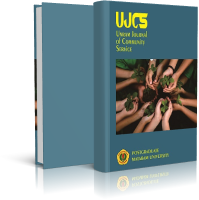Pembatasan Usia Pemberangkatan Jamaah Haji Maksimal 65 Tahun Dampaknya Bagi Umat Islam di Kota Bima
DOI:
10.29303/ujcs.v3i1.202Published:
2022-03-31Issue:
Vol. 3 No. 1 (2022): MarchKeywords:
Hajj, Age, AbleArticles
Downloads
How to Cite
Downloads
Metrics
Abstract
Performing the pilgrimage for Muslims is obligatory for those who can afford it. This pilgrimage is included in the fifth pillar of Islam. The category of being able means being financially able to bear all costs and being physically and mentally healthy. For the Indonesian nation, whose population is predominantly Muslim, the pilgrimage has become a part of people's lives. Because of that, various ways and methods have been developed to be able to go for Hajj from the early days of Islam until the colonial era until independence. All of that is formed and patterned along with economic growth and the level of community welfare so that Hajj has become part of the culture of the community. Even the title of Hajj has been pinned into a separate prestige in the midst of society. To be able to realize the dream of going for Hajj, various ways are taken, starting from selling assets, working hard, and saving for years and even a lifetime for people with low incomes. For the rich, high-income groups, Hajj is not a problem and can be done many times. But for ordinary citizens with middle to lower-income, Hajj is something of a luxury, something that is luxurious and can be risked for a lifetime to make it happen. Rules limiting the maximum age of 65 years for pilgrims who can go to destroy all expectations of society who make the pilgrimage as a purpose of life. In fact, many of them think that dying in Mecca is happiness and even jihad because they are worshiping. So, they do not question all the risks of taking the pilgrimage. The Government should respond to this aspiration by submitting a lobby to the Kingdom of Saudi Arabia with rational considerations and prioritizing the benefit. This Policy Paper begins by explaining the general conditions of the Hajj in Bima City, data, and the number of queues for departing pilgrims, then identification of problems and their impact on the conditions of the religious life of the community.
References
Basid, A., & Ibrahim, F. M. A. (2022). Pergeseran Kultur Budaya Haji Dan Umroh Di Era Covid 19. Prosiding Konferensi Integrasi Interkoneksi Islam Dan Sains, 1, 321–326.
Idawati, M. (2017). Persoalan - Persoalan Kontemporer yang Terjadi dalam Pelaksanaan Ibadah Haji. Journal of Chemical Information and Modeling, 53(9), 3–5.
Keputusan Menteri Agama Republik Indonesia Nomor 405 Tahun 2022 Tentang Kuota Haji Indonesia Tahun Hijriah 1443/ 2022 Masehi
Peraturan Menteri Agama (PMA) Nomor 13 Tahun 2021 Tentang Penyelenggaraan Ibadah Haji Reguler
Zubaedi. (2014). Analisis Problematika Manajemen Pelaksanaan Haji Indonesia (Restrukturisasi Model Pengelolaan Haji Menuju Manajemen Haji yang Modern). Paper Knowledge . Toward a Media History of Documents, 7(2), 107–115
License
Copyright (c) 2022 Syahruddin Syahruddin

This work is licensed under a Creative Commons Attribution 4.0 International License.
You are free to:
- Share — copy and redistribute the material in any medium or format for any purpose, even commercially.
- Adapt — remix, transform, and build upon the material for any purpose, even commercially.
The licensor cannot revoke these freedoms as long as you follow the license terms.
Under the following terms:
- Attribution — You must give appropriate credit, provide a link to the license, and indicate if changes were made. You may do so in any reasonable manner, but not in any way that suggests the licensor endorses you or your use.
- No additional restrictions — You may not apply legal terms or technological measures that legally restrict others from doing anything the license permits.
Notices:
You do not have to comply with the license for elements of the material in the public domain or where your use is permitted by an applicable exception or limitation.
No warranties are given. The license may not give you all of the permissions necessary for your intended use. For example, other rights such as publicity, privacy, or moral rights may limit how you use the material.





